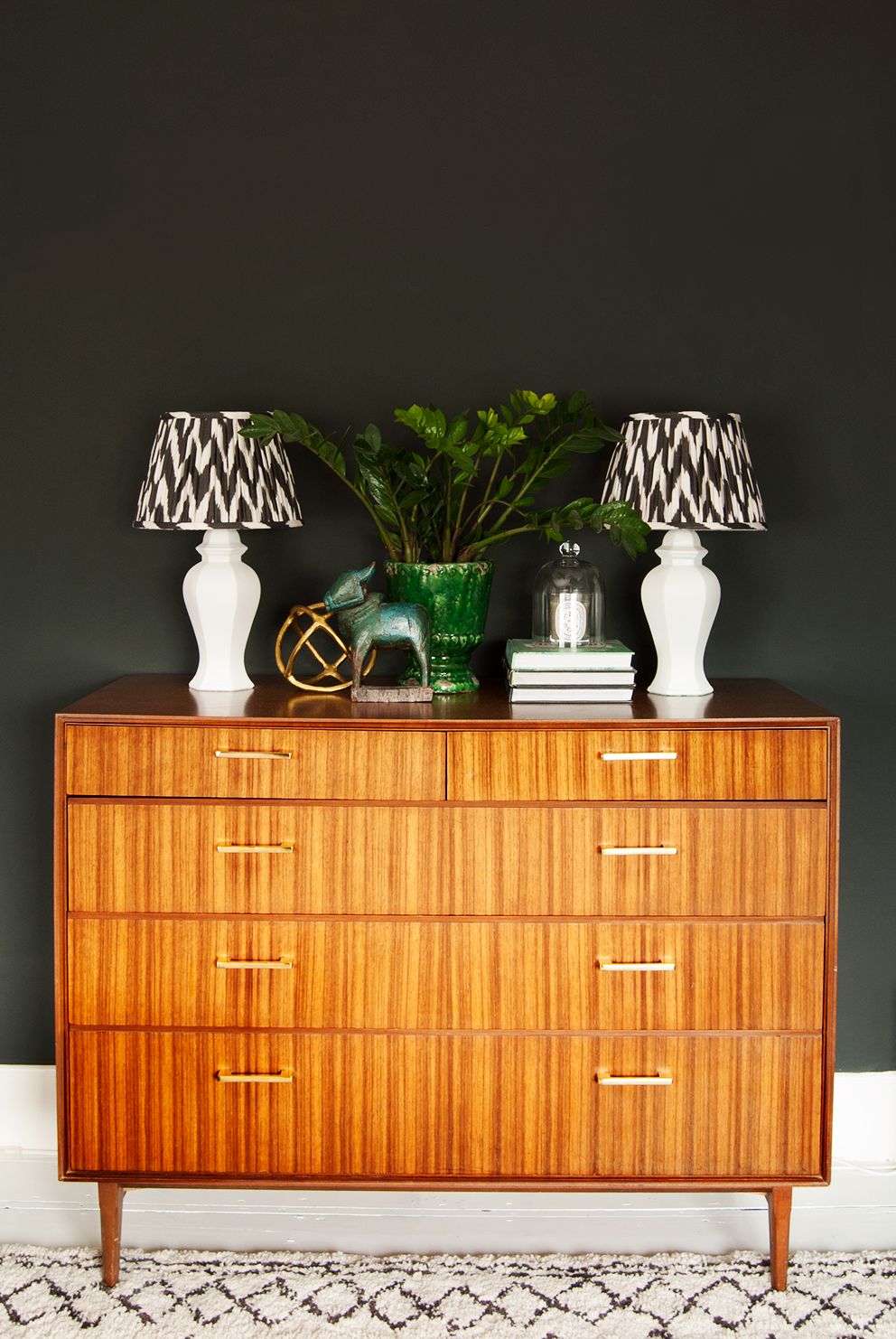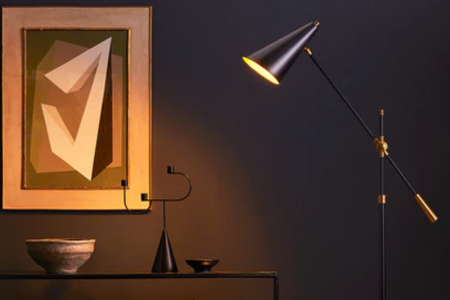
One of the Pooky product lines that seems to have really caught the imagination of customers and professional interior stylists is our range of ikat designer lampshades. But what exactly is ikat, and why does it work so well for shades?...
The picture below is our Crescent lamp, styled by the interior stylist par excellence Sophie Robinson (of BBC fame). She’s paired it with a yellow ikat pattern silk shade in one of her typically quirky, colourful, individual arrangements:
Pooky's yellow ikat shade atop a Crescent lamp - styled by Sophie Robinson. Photo credit.
Meanwhile, style writer Bianca Hall recently featured a pair black and white zig-zag ikat linen shades, against an off-black wall, on her interiors blog French for Pineapple:
The 30cm straight empire printed linen ikat shade in black zig-zag in Bianca Hall's sitting room
In fact, we recently devoted a whole post to interior designers who are using Pooky ikat stuff. So what is it about ikat? Or, perhaps the first question should be: what is ikat anyway?
A brief history of ikat dyeing
A young woman from Kambera, Sumba, pictured in 1931, wearing an ikat garment and with the warp for a cloth tied and ready for dying.
According to the V&A, the term 'ikat' comes from the Malay word 'mengikat', meaning to tie or to bind, although other sources point to similar words in Indonesian and Javanase languages. Anyway, ‘ikat’ as we use it refers to a particular process of dyeing fabric. Ikat is a very old kind of ‘resist’ dyeing. That’s where you to use some method to ‘resist’ or prevent the dye from reaching some parts of the cloth so that you get a pattern. Common traditional techniques include using wax or some sort of paste, but in the ikat method individual yarns are bound with a tight wrapping in the desired pattern and then dyed before being unwrapped and woven into cloth. For more complex, multicoloured patterns the binding process may be repeated several times – which takes a lot of skill. Essentially, it’s a lot like tie-dye, except that in ikat the dyeing is applied to the yarns before they are woven, rather than the final cloth. Nobody knows for certain exactly where the technique originated – and possibly it was developed independently in different places – but it has a long history in India, in South and Central America, Japan, Africa and Southeast Asia. The most complex form of ikat of all – called ‘double ikat’ – involves dyeing both the warp and the weft yarns to form a pattern.
Detail of a Gujarati 'patola' of double ikat from the early 19th century. Credit: Gift of Mrs. Harry Lenart (M.87.242), Los Angeles County Museum of Art
Basically that means that both the lengthwise and the transverse threads in a woven cloth have to be all matched up – a process so fiendishly complicated that only a few places - notably Patan, Gujarat in India - have ever really mastered it.
Blurred visions
One of the notable features of ikat is the extreme difficulty of precisely lining up the dyed threads so that the pattern comes out just right. Being able to achieve a perfectly clear final design is, of course, a highly-prized skill, particularly in Japanese ikat. But as is so often the case in life, perfect isn’t always necessarily best. Most ikat fabrics have a characteristic ‘blurriness’ – and that imperfect blurriness is itself an attraction for discerning textile enthusiasts.
A characteristically 'blurred' ikat cloth from Uzbekistan
It gives a final ikat product a lovely, human, handmade feel – one of the main reasons we like it so much for our lampshades, of course.
Silk and linen ikat shades
50cm straight empire shade in yellow silk ikat
Ikat patterns don’t have to be complex to work well. The simple yellow and off-white geometric pattern of the hand loomed silk shade favoured by Sophie Robinson – which we sourced from Tajikistan – is brilliant for the slightly shabby chic home styles that are currently so popular. The same goes for multicoloured shades, such as this ‘heraldic’ straight empire shade in natural linen, printed with a pattern that sort of reminds us of the colours of medieval heraldry (or is that just us?) Anyway, it’s in that lovely sweet spot that feels both traditional and contemporary:
30cm straight empire printed linen ikat shade in heraldic. Shop here.
Or simplest of all is the zig-zag pattern – either in a bold black-and-white as above, or in another colour such as this striking orange. That one was chosen by Lins of Boo & Maddie as her favourite of the Pooky ikat shades.
Pooky's orange zig-zag ikat linen shade looking fab in the hallway at Boo & Maddie.
But which is your favourite? Check out the full range of ikat silk and linen designer lampshades here, and let us know…

















